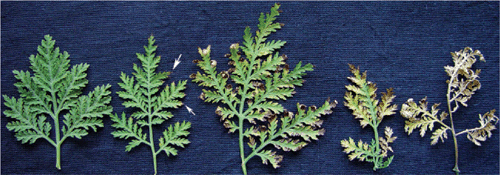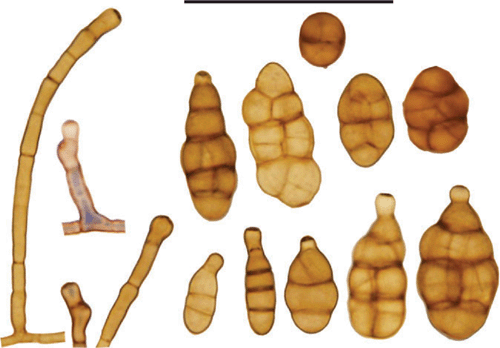First report of sweet wormwood leaf blight disease in India
J. N. Samanta A , B. D. Solanki B and K. Mandal A CA Directorate of Medicinal and Aromatic Plants Research, Boriavi, Anand, Gujarat – 387310, India.
B BRD School of Biosciences, Sardar Patel University, V.V. Nagar, Anand, Gujarat – 388120, India.
C Corresponding author. Email: mandal_kunal@yahoo.co.in
Australasian Plant Disease Notes 4(1) 78-79 https://doi.org/10.1071/DN09033
Submitted: 21 July 2009 Accepted: 27 July 2009 Published: 10 August 2009
Abstract
Artemisia annua is an important drug plant yielding antimalarial compounds. It was found to be infected by Alternaria alternata in India. The pathogen reduces active leaf area and is also known to produce mycotoxins. Hence, the disease demands serious attention to ensure the availability of a safe drug.
Sweet wormwood or sweet annie (Artemisia annua L.) is a commercially important medicinal plant used by traditional Chinese herbalists. The well-known Chinese physician Ge Hong prescribed use of a preparation from this plant against fevers as early as the 4th century BC (Hsu 2006). Interest in this plant was renewed after it was found to contain an antimalarial sesquiterpene lactone – artemisinin. It also yields an essential oil which is being used as a natural fragrance (Chopra et al. 1986).
To meet the increased demand, sweet wormwood cultivation has been initiated in different parts of India. The crop was introduced at Anand, Gujarat, India during December, 2007 and the crop growth was satisfactory. However, a leaf blight disease became prevalent during September, 2008. In later studies we observed that under field conditions, the disease was more common on mature plants (plants more than 50 days old). Within a plant usually the older leaves were first affected by the disease. The initial symptom was the appearance of minute, brown lesions on the leaf tip. Later these lesions enlarged toward the middle and lamina of the leaves which gradually turned yellowish. As the spots grew in size, the leaves often curled upward. Once the necrotic area covered the majority of the lamina, the leaf showed a blighted appearance. Ultimately the leaves dried prematurely (Fig. 1). In cases of severe infection, small branches and inflorescences also became blighted. If environmental relative humidity was high and/or in the case of dew deposition, numerous conidia lined the leaf surfaces.

|
A fungus was repeatedly isolated from the infected leaflets on potato dextrose agar (PDA). Monosporic cultures initially produced white-to-grey mycelia which became dark brown due to copious sporulation after 5–7 days. It produced mostly (62.0%) unbranched acropetal chains of multicellular conidia. Each chain contained 3–9 (5) conidia. After 7–10 days growth on PDA, conidia were 14.5–39.5 (25) × 7–18.5 (11) µm in size and of various shapes (Fig. 2). The fungus was identified as Alternaria alternata (IMI397007, ITCC6470).

|
Pathogenicity was established by inoculating healthy plants. Healthy, mature leaves were spray inoculated with a suspension of ~3 × 104 conidia/mL during the afternoon and immediately covered with an inflated polythene bag to maintain leaf moisture and high humidity. Control leaves received the same treatment except that the conidial suspension was replaced by sterile distilled water. After 24 h of incubation, the bags were removed and the leaves monitored daily to note symptom development. Symptoms identical to those found occurring naturally were observed 5–7 days after inoculation. Alternaria alternata was reisolated from such leaves.
Alternaria alternata is a ubiquitous pathogen having a wide host range. However, after a search of the available literature, this is the first record of this pathogen on sweet wormwood and the first report of any fungal disease on this medicinal herb. Artimisinin is located in the glandular trichomes of the leaves, stems and inflorescences (Duke et al. 1994). Hence, the disease may affect artemisinin yield. The fungus is also known to produce several mycotoxins in different hosts (Patriarca et al. 2007). Hence, the occurrence of this disease needs serious attention to ensure the herb’s quality as a safe drug.
Acknowledgement
Authors are thankful to the Director, Directorate of Medicinal and Aromatic Plants Research (DMAPR), Anand for providing facilities for this work and allowing BDS to undertake dissertation work at DMAPR.
Duke MV,
Paul RN,
Elsohly HN,
Sturtz G, Duke SO
(1994) Localization of artemisinin and artemisitene in foliar tissues of glanded and glandless biotypes of Artemisia annua L. International Journal of Plant Sciences 155, 365–372.
| Crossref | GoogleScholarGoogle Scholar |

Hsu A
(2006) The history of qing hao in the Chinese materia medica. Transactions of the Royal Society of Tropical Medicine and Hygiene 100, 505–508.
| Crossref | GoogleScholarGoogle Scholar | PubMed |

Patriarca A,
Azcarate MP,
Terminiello L, Fernández Pinto V
(2007) Mycotoxin production by Alternaria strains isolated from Argentinean wheat. International Journal of Food Microbiology 119, 219–222.
| Crossref | GoogleScholarGoogle Scholar | PubMed |



